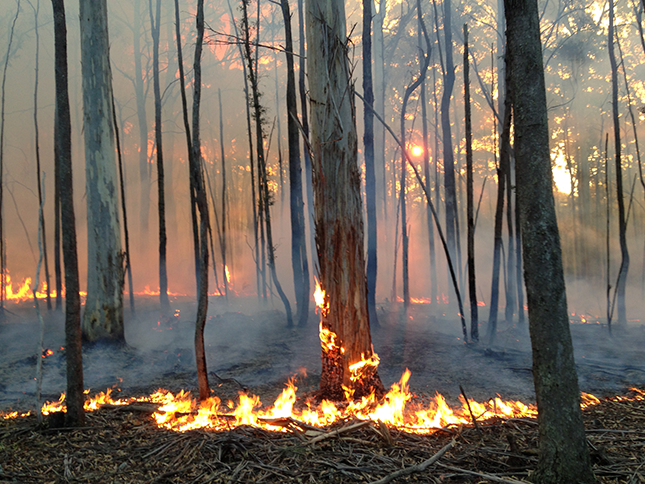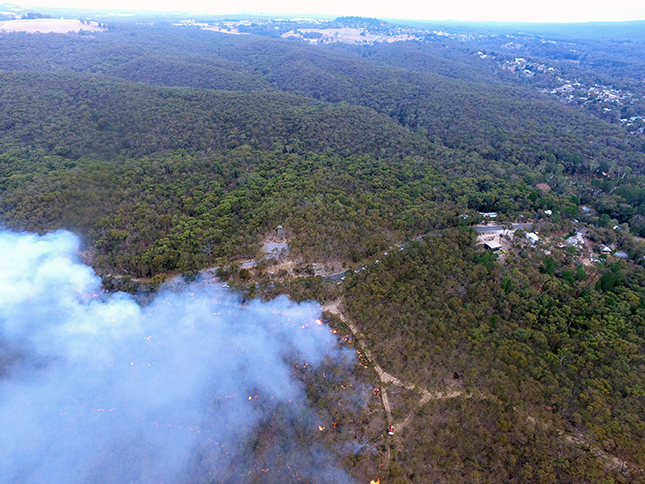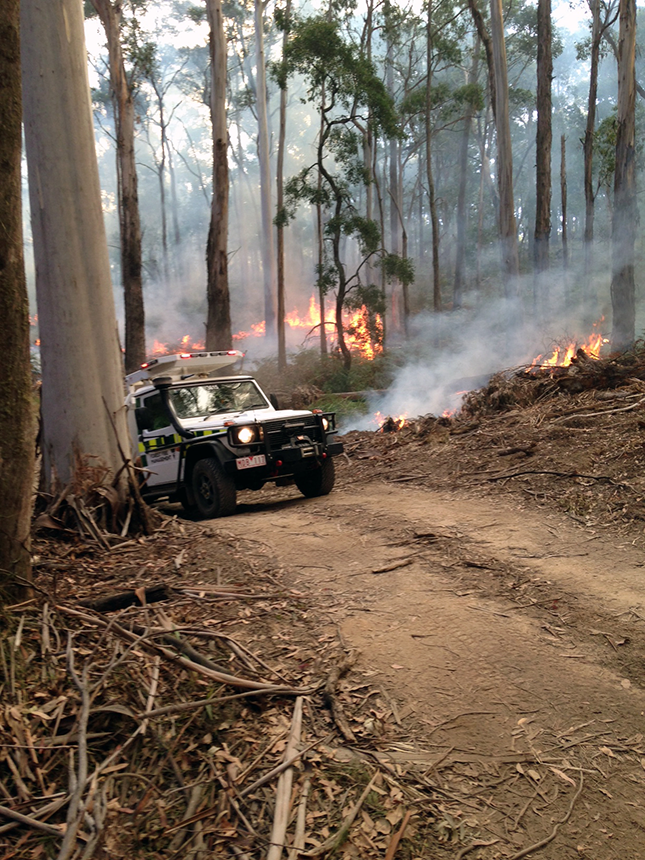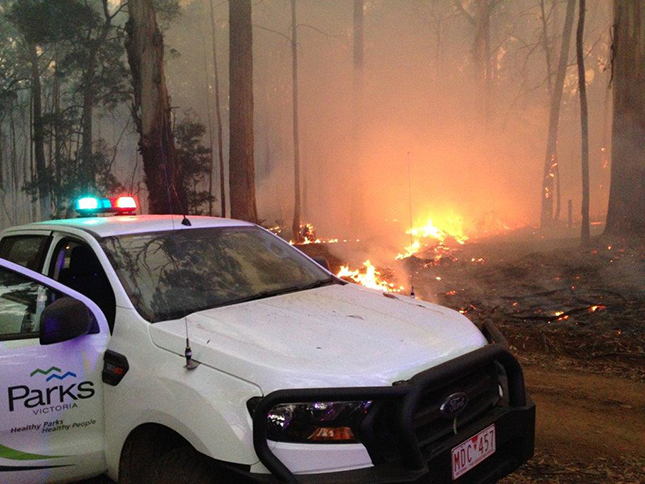Abstract
Designing and delivering a planned burning program involves reliance on complex planning and operational expertise. On public land, fire agencies dedicate significant resources to these programs, many of which have increased in scope as government and community expectations evolve. Since Black Saturday in 2009, Victoria’s fire services have shifted significantly in their approach to identifying and managing bushfire risk. Most notably, ‘risk landscape’ planning and the development of high-level policy statements such as Safer Together (State Government of Victoria 2015), have moved conversations about bushfire risk to a ‘cross tenure’ or landscape context and a community-based setting. This paper argues that one element not yet greatly affected by these changes is the design of on-ground burn delivery teams. In Victoria, the Burn Officer in Charge (BOIC) has been a pivotal position in delivering prescribed burns. This role has many dimensions and, as policy and operational demands increase, the structure of operational burn teams and the associated role of BOICs needs reconsideration. Innovation in areas of weather services, community engagement and use of aerial resources has been driven by technological development and research over the last decade. Nevertheless, the way that burn teams are structured has not witnessed comparable change. This paper describes and recommends adoption of a revised burn team structure in pre-burn tactical planning and knowledge management. These changes offer significant outcomes for government and communities.
Background
Lancefield 2015: catalyst for change
In October 2015, a prescribed burn in the Cobaw State Forest north of Lancefield in central Victoria escaped control lines twice in three days. On the second occasion, the fire ran well beyond the burn boundary and resulted in the loss of houses, fences and other assets. Escapes of this scale trigger a review of operational practice. The investigation of the Cobaw State Forest fire and the associated government response (DELWP 2015a, 2015b) generated important recommendations to improve practice. However, while the investigation explored elements of the roles tied to prescribed burn delivery, it did not touch greatly on the design and tasking of burn teams. Rather, it presented recommendations related to the adoption of important new risk management systems and changed approaches to burn approvals and oversight. The scope of community involvement in the design of burn programs was also analysed.
At a practical level, the Lancefield incident accelerated the adoption of new approaches to burn planning and risk assessment in Victoria; namely the Planned Burn Risk Assessment Tool (PBRAT), which was being trialled by fire services in the Australian Capital Territory and New South Wales. PBRATs provide a structured and documented way to assess the operational complexity of a burn, the risks associated with its delivery and the key steps to mitigate risk such as establishing control line standards and operational resourcing (Levine et al. 2017).
One of the points made in the Lancefield investigation was that BOICs need to be involved in the burn risk assessment process (DELWP 2015a, p. 9). Use of the PBRAT has strengthened the relationship between BOICs and burn planning and approvals teams by providing a structured process.
However, redesign of on-ground burn delivery teams has the potential to connect operational practice more effectively to these new systems and to bring about a shift in standards and approaches that matches the evolution of broader policy and procedural changes.

Prescribed burn in the Wombat State Forest, Central Victoria, in 2018. Image: Anthony English
Operational complexity
The on-ground delivery of a prescribed burn is inherently complex. This creates an ongoing need to review how burns are managed and delivered. This complexity is not necessarily influenced by the size of the burn. A range of factors can shape complexity. As an example, planning a small burn adjacent to houses or other assets can present significant challenges that a BOIC, crew and overseeing Burn Controller must account for.
In any prescribed burn, multiple variables exist:
- Dynamic environmental factors: weather, topography, fuel and smoke all interact in ways that can challenge expectations and require quick thinking by crews on the ground. Minor effects such as changes in relative humidity, the way that a gully system channels wind or the thickness of the canopy and associated shade can all influence fire behaviour and the outcome of a planned burn.
- Team dimension: effective delivery of a burn relies on good team dynamics and clear tasking. The ways that crews and BOICs manage communication, fatigue and decision-making are influenced by team member attitudes and experience, as well as their ability to read and anticipate conditions and the effects of decisions on future outcomes. A BOIC may have to manage different crew behaviours or views within the team about how and how much fire should be applied during an operation. This challenge can be heightened if a BOIC is allocated a crew from out-of-area who may be unfamiliar with the fuel and vegetation types present in the burn area.
- Community: this variable has many important elements. Depending on a burn’s location, a BOIC may need to consider the effects on neighbours and manage the timing of operations to reduce impacts on individuals, businesses and communities, especially from smoke. Burn windows can be dictated partly by the onset of events such as holiday periods, crop harvesting or community events. In some cases, crews and BOICs may need to deal with people who are concerned or frustrated about smoke or other risks of a planned burn. Burn operations may also involve management of traffic and road use.
- Environmental and land management objectives: in most cases a burn plan will include objectives that have been developed by district burn planning teams. A BOIC will need to consider these when designing lighting patterns and when allocating resources to patrol.
- Complex and changing risk to crews and their safety: there are good reasons why agencies emphasise that BOICs and crews use a Dynamic Risk Assessment approach before, during and after prescribed burns. Terrain, trees, smoke, powerlines, vehicle traffic, dehydration, variable crew experience, fatigue, poor communication or tasking and even comment from neighbours, can impact on crew safety and capacity to function well.
New risk analysis procedures such as the PBRAT system and the subsequent resourcing and planning that this analysis generates, represent an improved approach that, in part, helps to mitigate this complexity. The inherent quality of the leadership and direction displayed by BOICs is also critical in the successful delivery of a burn operation. Nevertheless, field operations are exposed to complex variables and this is a good reason to reassess how teams are structured. The picture painted here highlights the cognitive load borne by a BOIC during an operation. It is argued that the role of the BOIC needs to be supported by an effective burn team structure.
Current practice in Victoria
The following information is drawn from the author’s experience in central Victoria over more than a decade. While it does not necessarily reflect the variation that may exist across Victoria, it is illustrative of current practice.
The BOIC is fundamentally responsible for overall delivery and management of the burn once ignition occurs. This is emphasised in the most recent Bushfire Management Manual and associated Joint Standard Operating Procedures (DELWP 2016). The BOIC role in Victoria requires accreditation as an Operations Officer Level 1 and at least 15 days experience in leadership roles at prescribed burns (DELWP 2017). The formal role statement indicates that the BOIC is ‘the person on the line responsible for the execution of all aspects involved with the planned burning operation’ (DELWP 2017). While every burn operation is overseen by a Burns Controller who, in Victoria, must be an accredited Incident Controller, the BOIC is primarily responsible for decisionmaking and the adaptive management of resources and tactics on the ground.
Typically, the BOIC is responsible for allocating staff to the roles of lighting crew leaders and sector commanders on the day of the burn. BOICs tend to choose people they know who are accomplished in these roles and who communicate well.
A BOIC may appoint other roles on the day such as spotters to observe and document fire and smoke behaviour. Most BOICs will also appoint a support person or ‘scribe’ to assist with key tasks such as managing radios, maintaining a log and taking weather and fuel moisture observations. Specialist equipment operators such as first attack dozer drivers, tanker drivers and vehicle-mounted drip torch crews will typically have been pre-planned through the resourcing process overseen by the district burn planning team.
In many cases, the crew assigned to the operation will not have seen the burn area prior to the day of ignition and will not have seen a copy of the burn plan or operations map before arriving at the site. This includes those who may be tasked to critical roles of lighting crew leaders or sector commanders. Therefore, there is an inherent reliance on the underlying experience of individuals, the pre-ignition SMEACQS briefings1 and the use of common operating systems to manage burn operations.
Several challenges can emerge from this approach. These include:
- BOIC as pivot instead of a team approach: many BOICs will seek to closely manage the detail of a burn’s delivery, partly because of the historical emphasis on the breadth of the role, but also because they tend to be the most aware of the burn unit characteristics, risks and associated burn plan. This can limit effective delegation of tasks to others and reduce collective accountability for burn operations. While there is already an agreed process of delegating roles in a team setting, the BOIC role is a central point of decision-making that can mean there is lack of clear accountability for roles such as sector commander and lighting crew leader. Delegation and tasking for these roles usually only occurs in any detailed way during the pre-ignition briefing. Because of this, in some cases, the BOIC may not be clear about where their own role ends. Consequently, a Sector Commander or Lighting Crew Leader may defer decisions to the BOIC or perform their function without accepting or understanding the extent of their accountability or the scope of the whole operation.
- lack of specialist training or accreditation for key roles: there is currently no specific training for lighting crew leaders or patrol crews in their roles at a burn. Agencies rely on experience and mentoring to develop this capability. Thus, the potential for variability in approach can impact on the effective delegation of tasks across the team structure.
- lack of pre-burn tactical planning as a team: under current arrangements, crew familiarity with a burn unit, the challenges being managed by BOICs and detailed implementation plans will only be addressed on the day of the operation via the SMEACQS briefings delivered by the BOIC. This offers little scope for an effective team-based review of tactics and challenges.
- tipping points for BOICs and loss of effective oversight: the BOIC is often stretched across multiple issues and tasks. As a burn progresses, the BOIC may need to oversee variables as diverse as many active burn edges, increased community interest, requests for additional resources and the management of crew shift changes.
These factors increase the risk of something going amiss, such as a burn escape, injury to crew, inefficient use and allocation of resources, poor communication and a reduction in the overall situational awareness of a burn team. These can manifest as:
- the clumping of patrol crews or a failure to maintain a patrol pattern that reflects the complexity of control lines due to a lack of team awareness of the burn unit’s geography and associated pressure points
- over resourcing by patrol crews of point-specific challenges such as individual burning hazardous trees due to the need for crews to manage not only general patrol, but also these more focused issues
- poor description or interpretation of observed fire behaviour and conditions by crews due to a lack of awareness of the overall tactical plan and, in some cases, lack of effective training and supervision
- poor whole-of-operation management of lighting patterns that can result in too much fire being put in, especially as crew members tire across the day or environmental conditions change.
These behaviours have the potential to lead to an injury or burn escape. While leadership exerted by key roles at a prescribed burn is critical, it is argued that challenges can be mitigated by better design, training and tasking of burn delivery teams.
A new approach
Three steps are proposed to improve the functioning of the BOIC and the accountability of burn teams:
- The creation of specific roles and associated accreditation in burn teams for lighting specialist, patrol specialist, hazardous tree specialist and weather specialist.
- The rationalisation of the roles of BOIC and sector commander so these become more manageable and increase their capacity to exercise overall strategic operational control.
- The use of pre-burn field inspections and team-based tactical planning involving the Burns Controller, BOIC and the other specialists.
It is critical that proposals align with the fundamental principles of AIIMS4; including unity of command and span of control (AFAC 2013). These new roles reinforce these principles and bring flexibility and scalability by embedding formal skills and experience by crews into a structure that better defines crew accountability. This approach supports the BOIC and sector commanders to maintain oversight of a prescribed burn operation. Table 1 outlines the proposed new roles.
The lighting specialist role would replace the current role of a lighting crew leader. The latter role is assigned at most burns but has no specific accreditation or training that relates directly to the application of fire to different vegetation types or the management of a crew across the life of a burn operation.
The patrol specialist role is currently part of the sector commander role. Typically, a Sector Commander oversees the management of lighting, patrolling and hazardous tree management. The Patrol Specialist would report to the Sector Commander and provide focused attention on the quality of patrol by crews. A Sector Commander may lose this focus because they deal with a range of other issues that can lead to poor management of patrol resources.
Importantly, the patrol specialist role would not necessarily add value on a small sector or burn. In this situation the oversight provided by this role could be managed by the Sector Commander or BOIC. The patrol specialist role would be best used on large sectors where a Sector Commander is unable to effectively traverse the line due to distance or difficult terrain. In addition, all crews need specific training on what constitutes effective patrol in different conditions. This training needs to be formally developed, irrespective of whether a patrol specialist role is ever developed.
The other two roles allow hazardous tree management and weather and smoke observation to be effectively delegated in a way that ensures they receive consistent attention across the life of a burn. Both roles would require training beyond that currently supplied to crews as general competencies. For example, all crews in Victoria receive training in hazardous tree identification and marking. The hazardous tree specialist however, could be trained and mentored to achieve a higher level of capability in the identification and actual treatment of hazardous trees during an operation. They could also oversee the safe use and tasking of advanced fallers and plant equipment such as excavators.

Interface burning in the Hepburn Regional Park adjacent to the township of Hepburn Springs in 2018. This image was taken by a drone that was used as part of the operation to provide the BOIC with real-time updates on fire behaviour and the smoke column. Image: Richard Adams, Parks Victoria

Prescribed burning in the Wombat State Forest, Central Victoria, in 2018. Image: Anthony English.
Clearly, not all operations require these suggested roles to be allocated to a structure. However, creating them would allow a burn team to be structured or scaled up to suit the operational complexity of a prescribed burn. They would allow a BOIC to formally allocate tasks against an agreed competency or role description that supports effective and, importantly, a formal delegation of functions.
Benefits of the change
Burning operations are complex and the implications of failure or safety incidents are high. The changes outlined here potentially generate a range of benefits that help manage this complexity.
First, they create a formal process for developing expertise and performance standards that match the complexity of operations and the implications of poor implementation.
Second, they provide a realistic and achievable scope of accountability for the BOIC as they create specific roles within teams. Operational procedures associated with crew safety, hazardous tree management, community engagement, shift management and other issues have become increasingly complex. The role of the BOIC as expert or pivot needs to be tempered by an emphasis on the team approach that places the BOIC in context.
Third, more effective tasking and professionalisation will benefit crew and community safety. The environmental risks present at a burn can be mitigated to some extent by good pre-burn management of hazards such as dangerous trees. However, the quality of supervision during a burn is as important as any pre-burn planning or physical management of risks. Role clarity and enhanced professionalisation would enhance the quality of supervision. Consequently, a safety culture that limits the effects of poor decision-making or inadequate risk assessment by crews due to fatigue, or lack of experience and training, could be fostered.
Table 1: Proposed new roles, accountabilities and operational benefit.
| Role | Responsibilities | Operational benefit |
|
Lighting Specialist (replaces Lighting Crew Leader) |
Reports to the Sector Commander if the burn is sectorised, otherwise to BOIC. Oversees deployment of crew according to direction from Sector Commander and BOIC regarding lighting pattern. Monitors lighting crew safety and compliance with operational procedures. Updates BOIC and Sector Commander(s) on progress, issues and fire behaviour. Monitors and adjusts lighting in collaboration with the BOIC and Sector Commander(s). Prevents under or over application of fire, loss of effective communications between lighting crew members and loss of effective reporting to the BOIC. |
Opportunity to formalise the role accountable for the application of fire during an operation. For example, the role could be trained to understand fire behaviour in different conditions and vegetation types. Limits potential for over or under application of fire. Provides more direct management of lighting crew performance and safety. Creates a team structure that encourages communication between crew members and upward to the BOIC. Limits potential for other staff to negatively impact on a prescribed burn by adding fire or directing lighting crew members to add fire outside the direction from the BOIC. |
|
Patrol |
Reports to the Sector Commander if burn is sectorised, otherwise to the BOIC. Monitors crew safety and their compliance with safe working procedures and tasking and reports on these factors to Sector Commander(s) or the BOIC. Updates the BOIC and Sector Commander(s) on the effectiveness of the patrol pattern. Assists the BOIC or Sector Commander(s) to prevent bunching of patrol resources or loss of coordination between patrol and lighting crews. |
Opportunity to develop accreditation in the management of patrol tasks. Provides capacity for improved oversight of crew performance and safety at larger or more complex prescribed burns. Assists the BOIC and Sector Commander(s) to understand the effectiveness of patrol and resource allocation during the operation and supports BOIC and Sector Commander |
|
Hazardous Tree Specialist (and team) |
Reports to Sector Commander(s) if burn is sectorised, otherwise to the BOIC. Assesses tree risk throughout the operation on defined sector(s). Monitors the condition of hazardous trees identified by crews on defined sector(s) and advises the BOIC and Sector Commander(s) on risk and treatment options. Oversees the management of dedicated crew or plant tasked pre-burn to manage hazard us trees during the burn operation. |
Provides dedicated resources to safety and control issues that are not diverted by other operational needs such as patrolling or extinguishing spotting. Supports enhanced crew safety by providing expert assessment and targeted response by a dedicated team. Allows continuity in tree risk assessment during the operation. Assists patrol crews to maintain patrol discipline by providing a dedicated resource that allows them to focus on their core tasks. |
|
Weather Specialist |
Reports to the BOIC. Takes weather and fuel moisture readings at agreed times and locations and provides data to BOIC. Analyses trends in data and provides this insight to the BOIC. Observes smoke columns and advises the BOIC of any issues arising such as impacts on local communities, businesses, roads and traffic. |
Provides the BOIC and the Burns Controller with regular and high-quality weather information and analysis. Enhances crew safety and supports BOIC decision-making. |
Finally, improving role definition and training assists with knowledge transfer in teams and generates a learning culture and agency agility. It assists agencies to adapt to changing circumstances such as staff retirement and associated loss of field skills as well as shifts in environmental conditions. These changes would also generate career paths in fire management that encourages continuous improvement and recognises the often whole-of-career dedication of staff.
Combining with pre-burn field-based tactical planning
Even if these suggested changes are not formally adopted, there are opportunities to create shared team assessment and awareness of burn units and the approach to delivering a proposed operation. In the Western Basalt District at Parks Victoria, preburn field visit trials have taken place with key staff who are to be allocated to a burn. The focus of these on-site discussions is on tactics, risks and objectives. Historically, BOICs have tended to undertake this assessment in isolation and then rely on local knowledge and staff experience for safe delivery on the day. By pre-assigning the specialist roles flagged here and taking that team into the field before a burn, safer and more effective burn operations can be designed and delivered. This approach represents an attempt to access and share staff tacit fire knowledge at the team level (English 2016). Several tools can be used to stimulate discussion, such as the Pre-Mortem Assessment approach (e.g. Johnson 2011).
The value of this approach is enhanced if field inspections include operational delivery staff and the district planning team, who are responsible for working with the BOIC, to develop the burn plan and the PBRAT.

Prescribed burning operations relies on the use and management of a diverse set of skills. Placing the BOIC role into a well-defined team setting helps mitigate inherent challenges associated with performing the role. Image: Anthony English.
Conclusion
No system of work is foolproof. Safe and effective burn operations are dependent on people’s behaviour and their skills, as well as constant vigilance, continuous training and review. What is proposed is not a panacea for preventing firefighter injuries nor prescribed burns that cause environmental consequences or escapes. The proposal does however, provide a pathway for operational practice to evolve and keep pace with the changes occurring in the policy area governing program design.
Footnotes
- SMEACQS briefings encompass Situation, Mission, Execution, Administration, Communications, Questions and Safety of the burn operation.


